Introduction To Thumbnailing And Quick Sketching
Introduction To Thumbnailing And Quick Sketching
TipsSketching Disclosure: This post may contain affiliate links. That means if yous buy something we get a small commission at no actress cost to you(acquire more than)
Thumbnail sketching is a vital footstep in the artistic process. This is particularly true of visual arts like illustration, concept art, and even graphic design.
Merely how should you get near creating thumbnails?
And what value do they add to the overall creative procedure? I desire to share some tips on thumbnailing for artists explaining how this initial stride offers rapid idea generation and helps artists nail downwardly new ideas quicker.
Why Carp Thumbnailing?
It's difficult to get this into some people's heads, just thumbnailing is one of the most important steps in the creative process. Thumbnailing and eventually picking an idea defines what you'll be doing in every other stage of a project.
By fleshing out thumbnails first you can eliminate ideas that you don't similar. You'll also stumble onto small-scale elements, features, curves, lines, and perspectives that you do like.
In essence information technology's similar window shopping and trying on lots of apparel to find the right outfit. If you're a costume designer this metaphor may be taken quite literally.
If you lot skip thumbnailing and dive right into a piece yous'll be left cleaning up lots of things along the way. The initial thought may be really cool, but you'll likely end up refining certain concepts, revamping others, and spending excess fourth dimension refining some ideas to be clearer.
Thumbnailing helps you lot avoid these pitfalls and it'south really elementary to learn. If yous know how to sketch then you accept the technical skills to thumbnail. All that'southward left is the technique for rapidly budgeted new ideas.
If you have an hr of time for a groundwork video while drawing, cheque out this FZD video where Feng Zhu covers the importance of thumbnailing.
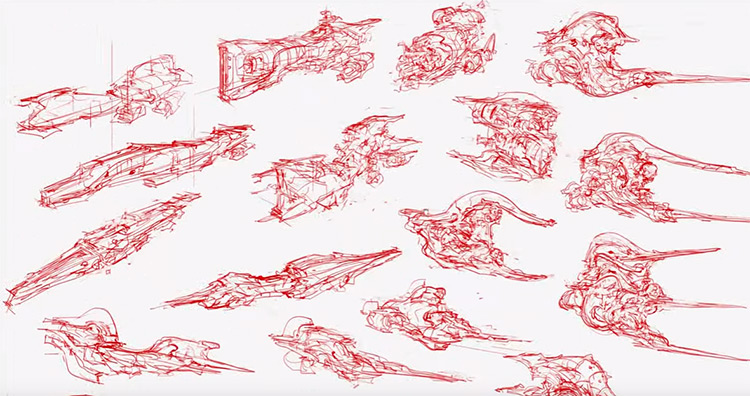
So why exactly should you bother thumbnailing? A few great reasons:
- Allows quick iteration over unique ideas
- Forces yous to recall almost what you're creating
- Freedom to design without worrying well-nigh technique
By removing restrictions on rendering and attending to detail you tin can put downwardly ideas much faster. This shifts your focus onto the ideas themselves, rather than making them await pretty.
If yous're trying to solve a artistic problem and then thumbnailing can also help you avoid artist cake.
Reduce Overthinking
The goal of thumbnailing is to put down concepts on newspaper. Try unlike designs as they come into your head. Attempt different perspectives, tones, locations, sizes, and features without overthinking too much.
These rough sketches are not meant to exist finished concepts. They don't even have to represent finished concepts, only more like ideas leading towards a finished concept. You lot want to sketch with no pressure and complete liberty.
Many artists will ask "how long does it take to complete a thumbnail"? It'southward not piece of cake to answer and depends greatly on the thought you want to put downwards. But I'd limit yourself to somewhere between three-10 minutes per thumbnail.
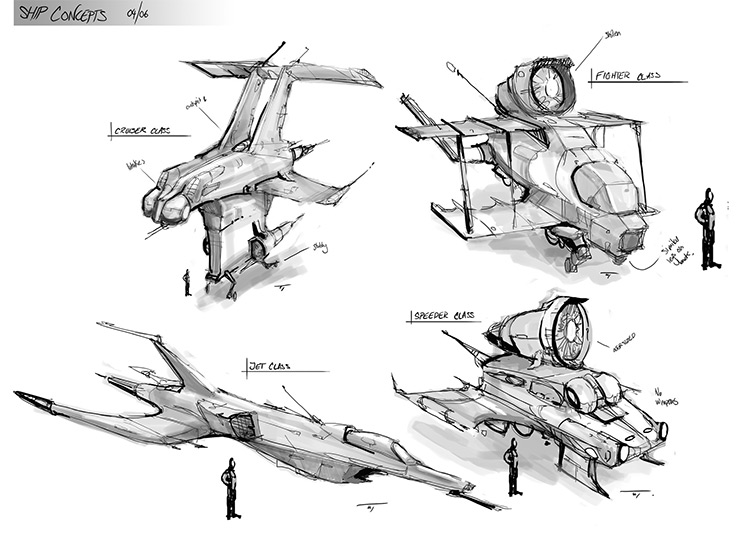
Once you find something you lot actually love and want to flesh information technology out, that's when you might move on from thumbnailing into further exploration and detailed rendering.
But the less you're thinking well-nigh the amount of time beingness spent, the meliorate you'll feel and the more fun you lot'll have just getting ideas down.
If you ever feel stuck I recommend you pull ideas from reference photos. Take a intermission and browse inspiration galleries to find various elements that y'all like in other pieces.
From hither it'll go much easier to put downwards ideas without thinking too much.
Note that you practise want to exist thinking nigh your thumbnails a trivial, but not overthinking. You lot want to consider new ideas for each new thumbnail but try not to limit your ideas or criticize as well rapidly.
You more often than not want a unique direction for each thumbnail, or at least a vague idea in heed. Iterating on the same idea over and over won't yield great results. This is why studying photos and other pieces of artwork tin can break habitual patterns and aid you recognize new ideas.
Simplifying Values
One big recommendation for thumbnailing is to limit the amount of tones you use in a sketch.
With only a few grayscale colors you'll stop up with bones silhouettes that remove details from your drawings. It may seem counter-intuitive merely you desire to simplify your work in the first.
When yous worry too much about the details yous're prone to go too far in-depth with the work. This is true of artists from all backgrounds and skill levels.
But thumbnails are not meant to be finished pieces. They're not meant to be super detailed, but rather simply detailed plenty to convey your idea.
Think more than in terms of outlines and shapes. The outline defines how the concept volition look, experience, and fit into 3D space. With a simpler prepare of values you lot're left thinking more in terms of shape and positioning.
So how many values should you use? This is entirely upwardly to you and your level of detail. Some artists can work with 2-iii while others prefer 7+ values. Information technology's totally acceptable to use a full palette of colors, only when commencement starting your thumbnailing process you'll notice more ideas quicker if you limit your palette.
Take a look at this informative post offering more detail on what'due south possible with thumbnailing.
Level of Detail
This is a tricky area of thumbnailing considering everyone has their own answer. I can't tell y'all exactly how much detail you need for a thumbnail. Some artists get by with scribbles. Others prefer to render a bit and infer shadows/lighting with tone.
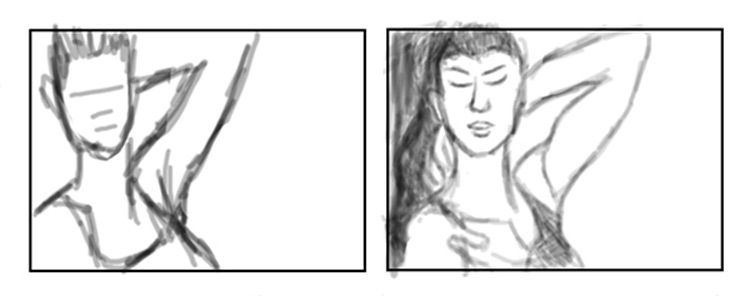
If you're looking for a direction then I say trust your gut. If you actually demand some particular to help you meet the thumbnail better then put in the extra time. If you tin get by with scribbles and still understand your piece of work, and then that'due south a smashing strategy to get new ideas quickly.
Detail is upward to the creative person because these initial thumbnails are made solely for you. As the creative person y'all'll be using these thumbnails for your own personal advantage. Nobody else needs to encounter them, and so truly make them your own and use as much detail every bit needed to help you find a great pattern.
There'due south a overnice Tuts+ tutorial roofing how to thumbnail in Photoshop. If you're new to digital painting and concept art I highly recommend post-obit that tutorial for some pragmatic techniques.
And if y'all're looking for tips on rendering I've establish How To Render by Scott Robertson to be the tome of practical advice.
Thumbnailing Setup
Depending what you're drawing you may offset thumbnails with a box or series of boxes on a page. This is a great method for environment sketches merely may be too limiting for characters or props.
Since you know the goal is to convey ideas, just first drawing whatever comes to mind. Be prepared to refuse the vast majority of your work. In fact, you may fill a canvas and not really love a single concept.
This is normal and only part of the process. Yous shouldn't feel discouraged or worried that you're on the incorrect path. It's simply a matter of getting ideas down and moving with the designs that feel right.
Some artists may prefer the traditional road of pencil and newspaper. This might be an easy way to start since you can take a sketchbook anywhere. Also pens/pencils merely depict in i color and so you're forced to piece of work with a limited palette.
One affair y'all should always go along in listen is the overall composition. It can be easy to get lost in idea heedless while sketching mindlessly. This isn't terrible, but not really the goal of thumbnailing. Some brainwork is required to think of new concepts.
The artistic composition will define many aspects of your concept. Perspective is critical to evangelize an idea that makes sense to you and your client/art manager.
If yous look up composition guidelines yous'll find recommendations like the rule of thirds or the golden ratio. These are both dandy and worth keeping in heed, just far from required for a powerful thumbnail.
Cleanup & Further Steps
The number of sketches yous create will depend on your projection and requirements. A good average to shoot for is between five-xx different concepts.
As you lot exercise you'll find it easier to come up upwardly with ideas that you beloved. This comes naturally from edifice your skills as an artist, observing items in the real world, and edifice your visual library.
Thumbnail practice as well helps you recognize ideas that y'all love. This seems obvious but it's proficient to refine your middle for aesthetics that meet your personal style, or that encounter the requirements of your electric current project.
Once you find one(or a couple) thumbnails that you like information technology's fourth dimension to flesh them out. You lot tin can stay in grayscale or add colour. Neither is wrong and you tin always add more item as you advance in the drawing.
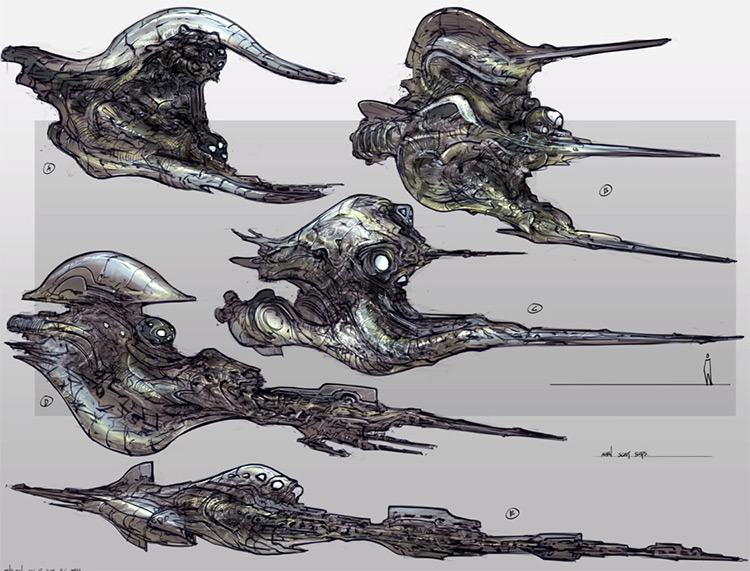
Also deviating from your initial thumbnail is completely OK. You may detect that only some aspects of your thumbnail actually meet your objective. Refining a sketch makes you look at the details, so you desire to pay attending to these details equally you refine. If they don't look right then make alterations.
Your chosen thumbnail does not need to be a final blueprint for the work. It's more like a set of guidelines that yous chose to follow, and these guidelines will assist tremendously throughout every further layer of refinement.
Thumbnails are truly versatile and a must-have in your concept art workflow.
This mail service is primarily about the early stage of thumbnailing to come up upward with unique ideas. But thumbnails tin even exist used in final pieces of concept art to showcase different perspectives, stances, dress, and alternate styles for props.
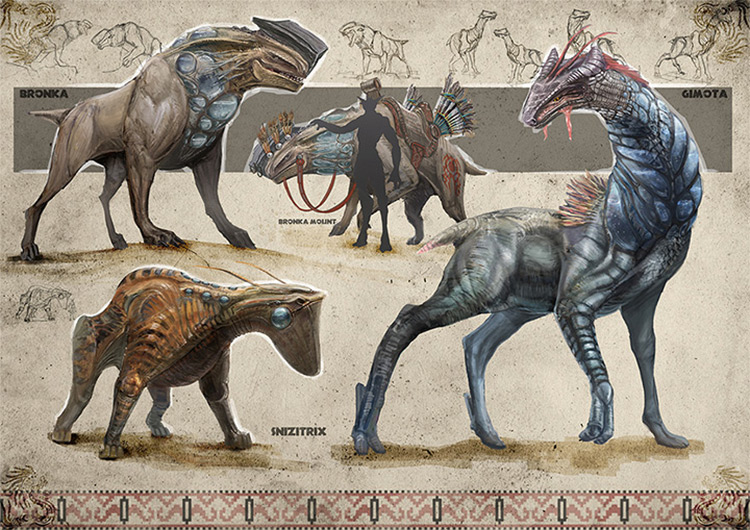
The case to a higher place is from FZD's 1st term student work and includes multiple thumbnails with a closeup of the confront, plus a meet-through anatomical view of muscles and bones.
Don't think of thumbnailing as a skill you tin pickup whenever you please. It'due south vital to every stage of concept art and virtually every other form of art/illustration.
It's a bully idea to start with a few thumbnails for every major project yous tackle whether commercial or personal. This volition ingrain the habit of thumbnailing into your mind so that it becomes a necessity for any new project.
And much like everything else in art, the more you do the better you'll get.
Source: https://conceptartempire.com/intro-to-thumbnail-sketching/
0 Response to "Introduction To Thumbnailing And Quick Sketching"
Post a Comment